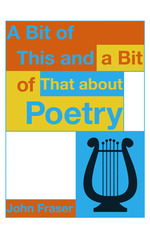
About the Author: John Fraser
JOHN FRASER was born in North London in 1928. During the War he was at a provincial grammar school, from which he won a junior scholarship to Balliol College, Oxford, which he entered in 1948 after two clerical years of National Service in the R.A.F. In 1953, thanks to the generous hospitality of Mike and Norma Zwerin, he moved to New York, where he was in the Trilling-Barzun seminar at Columbia.
In 1955 he entered the Ph.D. programme in English at the University of Minnesota, with a minor in Philosophy, including a term on Leibniz from Wilfred Sellars and aesthetics from Alan Donagan. After graduation, he and the artist Carol Hoorn (Fraser), who had married him in 1956, moved to Halifax, Nova Scotia, where he took up a position at Dalhousie University that would last for over years.
While still a graduate student, he did the article on 20th-century American and British poetics for the first edition of the Princeton Encyclopedia of Poetry and Poetics.
Cambridge University Press published his three print books. Articles of his appeared in the Partisan Review, the Southern Review, the Yale Review, and Studio International. In 1990 he gave the Alexander Lectures at the University of Toronto.
Since his retirement, he has added the equivalent of several books to his website (jottings.ca, webmaster Rob Stevenson), including the major revisionist anthology A New Book of Verse.

A reviewer of JOHN FRASER'S widely praised Violence in the Arts (1973) spoke of encountering in it "an extremely agile and incessantly active mind that illuminates almost every subject that he touches." As a reader of poetry he is in search of felt life and expressive form. He feels his way forward through poems as speech acts, rather than latching onto whatever Big Poetic Truths they are presumed to be disclosing, or treating them as raw material to be given significance by Theory. And he enters them from a variety of directions.
The components of A Bit of This and a Bit of That about Poetry include:
—A fast, funny bit of intellectual autobiography.
—A tracing of the stylistic changes by which poetry ca 1880-1920 had muscle and realworld grounding restored to it.
—A re-entry into his formative childhood experiences of poetry in the 1930s, including winning a BIG school cup at age ten by reciting forty proto-symbolist lines from Tennyson's 'Idylls of the King', whose linguistic strangeness he recreates here.
—Jargon-free commentaries on formal and referential aspects of a dozen of his favorite poems, with their glow-worms, and gondolas, and garlic, and so forth.
—A spelunking trip through the remarkable inner spaces opened up by the uncoupling of syntax from stanzaic form in George Herbert's "Church Monuments."
—Three common-language forays into theoretical matters (symbolism, imagination, genius, etc), with a healthy refusal to be awed by the Byzantine structures that have grown up around them.
—An interactive mix of observations and quotations about a variety of topics, including Greek and the Book of Nature, thrillers as paradigms, high Romanticism, lovely pop lyrics ("The sigh of midnight trains in empty stations"), and the Demon Weed.
Fraser's celebrations of plenitude and the energy-charged flow of verse make A Bit of This and That a book that can be enjoyed whether one is primarily into free verse or more regular kinds.
 A reviewer of JOHN FRASER'S widely praised Violence in the Arts (1973) spoke of encountering in it "an extremely agile and incessantly active mind that illuminates almost every subject that he touches." As a reader of poetry he is in search of felt life and expressive form. He feels his way forward through poems as speech acts, rather than latching onto whatever Big Poetic Truths they are presumed to be disclosing, or treating them as raw material to be given significance by Theory. And he enters them from a variety of directions.
A reviewer of JOHN FRASER'S widely praised Violence in the Arts (1973) spoke of encountering in it "an extremely agile and incessantly active mind that illuminates almost every subject that he touches." As a reader of poetry he is in search of felt life and expressive form. He feels his way forward through poems as speech acts, rather than latching onto whatever Big Poetic Truths they are presumed to be disclosing, or treating them as raw material to be given significance by Theory. And he enters them from a variety of directions.